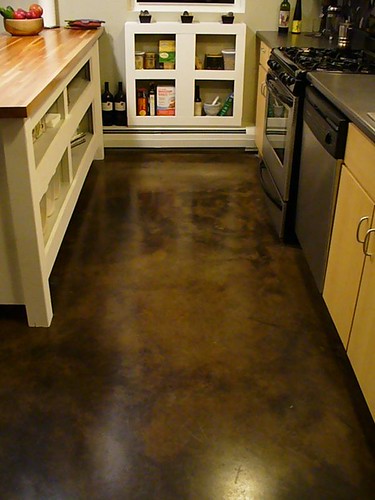Once marginalized as an unsightly but necessary building material, concealed by flooring, drywall, or any other façade as quickly as possible, concrete has finally found its day in the sun with designers and homebuilders. It’s not uncommon to see exposed concrete floors and walls in modern homes and offices alike. In fact, some interior designers have moved to using concrete as the focal point in their designs.
And it’s hard to blame them. Concrete is a functional, practical, durable and beautiful product (in that postmodern, brutalism sense). It makes for a hard-to-beat surface for floors throughout a home.
But what’s the best way to clean interior concrete floors?
First, it’s important to know whether you’re dealing with sealed or unsealed concrete floors—as the cleaning method varies between these two surfaces. Interior concrete surfaces should be sealed with a film-forming sealer, rather than the penetrating sealers used on exterior surfaces. Not sure if your floors are sealed? It’s easy to test for sealer. Simply pour a small amount of water on the surface. If the water beads up and doesn’t soak into the concrete after a couple of minutes, you know it’s sealed.
How to Clean Sealed Concrete Floors
Sealers create a protective, nonporous surface on top of the concrete. So, cleaning sealed concrete is straightforward and easy—much like the other floors in your home.
Simply sweep or vacuum up dust and loose debris off the floor. Then, mix one gallon of water with 1/8 cup of mild liquid dish soap and mop the floor with the solution. Proceed with caution, as the floor will likely be slippery. Rinse out the bucket and mop, then refill the bucket with plain warm water and mop again to rinse off any leftover residue. Let the floor air dry. Steer clear of harsh cleaners, which can break down the sealer over time.
Make sure to reapply sealer per the manufacturer’s recommendations to ensure your floors stay looking great for the long haul. This timeframe can differ drastically from product to product, but a general rule of thumb is that you should start looking into reapplying interior film-forming sealers after about five years. It may be helpful to talk with an experienced concrete professional to help you determine when it may be time to recoat.
How to Clean Unsealed Concrete Floors
Unsealed concrete is porous, which makes it susceptible to stains and wear. Therefore, it’s important to act quickly if anything is spilled onto the floor. Clean accidents up with a wet rag as soon as possible to avoid staining.
For day-to-day cleaning, go about it much the same way as described in the process for sealed concrete floors. Sweep or vacuum up dirt, dust and debris first. Mop a mixture of mild dish soap (1/8 cup) and warm water (one gallon) across the floor. Then, rinse with clean water and let the floor thoroughly air dry.
Attacking stains and stubborn messes takes a more concerted effort. Most stains won’t simply scrub away—although you can always try removing the stain with a mixture of dish soap and hot (or boiling) water and a stiff-bristled, nylon brush before going on to more aggressive approaches. If the dish soap and water mixture fails, you’ll need to “pull” the stain out of the concrete. Mix trisodium phosphate (TSP) with water and an absorbent material, such as kitty litter or sawdust, to create a smooth paste. Apply the mixture to the stain and wait until the paste dries. Then, sweep or vacuum it away. One application may not get rid of the entire stain, so patience and repeating the process may be necessary.
Be careful when working with TSP. Wear gloves and a long-sleeve shirt. Safety glasses and a respiratory mask are also recommended. When working indoors with TSP, make sure there’s adequate ventilation. Also, know that TSP can damage metal, ceramic tile, grout and glass, so proceed with caution when working around those surfaces. Some local regulations may have limited the use of TSP, so make sure to look into your local guidelines.
Premixed concrete stain removers may also be used. Just make sure to follow the manufacturer’s recommendations carefully. Even still, it may be best to test these products on a small, inconspicuous area of the floor before going after any stains in more visible areas.
Do NOT Use Vinegar on Unsealed Concrete
Don’t use vinegar or other acid-based cleaners for unsealed concrete floors. These can actually etch into the concrete, creating permanent or, at least, tough-to-reverse surface damage.
Intermountain Concrete Specialties
Cleaning concrete floors is similar to other types of hard flooring materials. Just make sure to use mild products for general cleaning to avoid damaging sealed floors. And when attacking stains in unsealed floors, take a graduated approach. Start with warm, soapy water and move to more aggressive methods with a mixture of TSP for those stubborn messes. Properly maintained, concrete floors will stay looking great for life. If you have any questions about maintaining concrete floors, contact Intermountain Concrete Specialties today. With seven locations from St. George, Utah, to Idaho Falls, Idaho, help is never far away.

